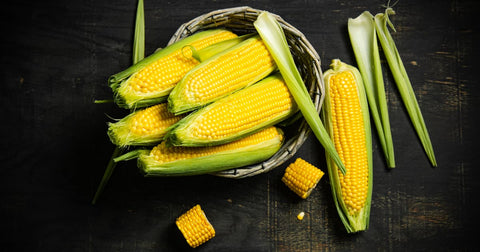Food intolerances have become a significant concern for many people, affecting their daily lives and overall well-being. Unlike food allergies, which trigger immediate and often severe reactions, food intolerances typically cause more subtle and chronic symptoms, making them harder to diagnose and manage. Among these intolerances, corn intolerance is one that is often overlooked yet increasingly prevalent.
Corn, a staple in many diets worldwide, finds its way into a myriad of food products, from obvious items like corn chips and popcorn to hidden ingredients in processed foods. This ubiquitous presence makes corn intolerance particularly challenging to identify and manage. Understanding corn intolerance is crucial for those who experience unexplained symptoms that could be related to their diet.

What is Corn Intolerance?
Corn intolerance, often confused with corn allergy, is a condition where the body has difficulty digesting corn and corn-based products. Unlike an allergy, which triggers an immediate immune response, an intolerance generally leads to digestive issues and other symptoms that can appear hours or even days after consuming corn.
Corn intolerance can vary in severity and may be influenced by the amount of corn consumed and the individual's sensitivity. It's important to note that corn is a prevalent ingredient in many foods, making it challenging for those with intolerance to avoid it completely.
While exact statistics on corn intolerance are not as widely documented as other food intolerances, it is recognized as a relatively common issue. It can affect people of any age, though it may be more commonly identified in adults who start to notice symptoms linked to their diet. Some studies suggest that food intolerances, including corn intolerance, are on the rise due to changes in dietary habits and increased consumption of processed foods.
Common Sources of Corn in the Diet

Corn and its derivatives are found in a multitude of food products, often in hidden forms. Common sources include:
- Whole Corn Products: Fresh corn, corn on the cob, popcorn, and cornmeal.
- Processed Foods: Corn syrup, corn starch, high fructose corn syrup, and corn oil are frequently used in processed foods like snacks, cereals, and baked goods.
- Beverages: Sodas and sweetened beverages often contain corn-based sweeteners.
- Condiments and Additives: Many sauces, dressings, and seasonings use corn derivatives as thickeners or sweeteners.
- Alcoholic Beverages: Some alcoholic drinks, especially beer and certain spirits, may contain corn.
Symptoms of Corn Intolerance
Corn intolerance can manifest in a variety of ways, affecting different systems in the body. It's important to recognize these symptoms, as they can often be mistaken for other conditions. Below are the primary symptoms associated with corn intolerance:
Gastrointestinal Symptoms
- Bloating: One of the most common symptoms, bloating occurs when the stomach becomes swollen with gas after consuming corn products. This can lead to discomfort and a feeling of fullness.
- Gas: Excessive gas can be a result of corn intolerance, causing frequent belching or flatulence. This symptom is often accompanied by abdominal cramps and pain.
- Diarrhea: Some people may experience diarrhea after consuming corn, which can lead to dehydration and electrolyte imbalances if persistent.
- Constipation: Conversely, corn intolerance can also cause constipation in some people, leading to infrequent or difficult bowel movements.
Dermatological Symptoms

- Rashes: Skin rashes can appear as a reaction to corn intake, presenting as red, itchy patches. These rashes may vary in severity and can be localized or spread across larger areas of the body.
- Hives: Hives are raised, itchy welts that can occur on the skin shortly after consuming corn. They can be particularly uncomfortable and may require medical treatment if severe.
- Eczema: Corn intolerance may exacerbate eczema, leading to increased itching, redness, and inflammation of the skin. This can be particularly troublesome for people with pre-existing eczema conditions.
Respiratory Symptoms
- Nasal Congestion: Consuming corn can lead to nasal congestion or a runny nose, similar to the symptoms experienced during a mild cold or allergy.
- Asthma-like Symptoms: In some cases, corn intolerance can trigger respiratory issues that resemble asthma, including shortness of breath, wheezing, and coughing. These symptoms can be alarming and may require medical attention.
Neurological Symptoms
- Headaches: Frequent headaches or migraines can be a sign of corn intolerance. These headaches may occur shortly after consuming corn or corn-based products.
- Fatigue: Chronic fatigue or an unusual sense of tiredness can be linked to corn intolerance. This symptom can affect daily activities and overall quality of life.
- Brain Fog: Some people may experience brain fog, characterized by difficulty concentrating, memory issues, and a general feeling of mental sluggishness.
Other Symptoms

- Joint Pain: Corn intolerance can sometimes cause joint pain or exacerbate existing joint issues, leading to discomfort and reduced mobility.
- Mood Changes: Changes in mood, such as irritability, anxiety, or depression, may be linked to corn intolerance. These changes can be subtle or pronounced, impacting mental health and well-being.
Diagnosis of Corn Intolerance
Diagnosing corn intolerance can be a multifaceted process, involving a combination of medical history, dietary changes, and specific tests. Here’s a detailed look at the steps involved in diagnosing this condition:
The first step in diagnosing corn intolerance is a thorough review of your medical history and tracking your symptoms. Keeping a detailed food diary can help identify patterns and potential triggers. Note what you eat, the timing of your meals, and any symptoms that arise afterward. This information can provide valuable insights for your healthcare provider.
Elimination Diet
An elimination diet is a cornerstone method for identifying food intolerances. This involves removing all potential sources of corn from your diet for a specified period, usually 2 to 6 weeks. During this time, it's crucial to be vigilant about hidden sources of corn in processed foods, medications, and even personal care products.
How to Conduct an Elimination Diet:

- Preparation: Before starting, consult with a healthcare provider to ensure you understand the process and what foods to avoid.
- Elimination Phase: Completely remove corn and corn-derived products from your diet. This includes obvious sources like corn syrup, cornmeal, and cornstarch, as well as less obvious ones like certain sweeteners, thickeners, and processed foods.
- Reintroduction Phase: After the elimination phase, gradually reintroduce corn back into your diet, one product at a time. Carefully monitor your symptoms during this phase. If symptoms return upon reintroduction, it is likely that corn is the culprit.
Food Sensitivity Tests
There are several tests available that claim to detect food sensitivities, including corn intolerance. These tests typically measure the levels of certain antibodies (such as IgG or IgA) in response to specific foods.
Types of Tests:
- IgG Testing: Measures the presence of IgG antibodies to corn in your blood. High levels may indicate sensitivity.
- IgA Testing: Similar to IgG testing but focuses on IgA antibodies.
Reliability and Limitations: While these tests can provide useful information, they are not definitive. False positives and negatives are possible, and results should be interpreted in the context of clinical symptoms and dietary history. It’s essential to use these tests as part of a broader diagnostic approach rather than relying on them solely.
Managing Corn Intolerance
Managing corn intolerance involves careful planning and attention to dietary choices. Below are some strategies to help people navigate their condition effectively:
Dietary Adjustments
One of the primary steps in managing corn intolerance is making dietary adjustments. This involves identifying and avoiding foods that contain corn and corn-derived ingredients.
- Identifying Hidden Sources of Corn: Corn is a common ingredient in many processed foods and can be listed under various names, such as corn syrup, corn starch, dextrose, maltodextrin, and high-fructose corn syrup. Be vigilant about reading food labels to identify these hidden sources.
- Reading Food Labels: Learning to read food labels meticulously is crucial. Ingredients lists and allergy warnings can help you spot corn-based components. Pay attention to terms like "modified food starch," which may be derived from corn.
- Alternative Grains and Starches: Incorporating alternative grains and starches into your diet can help you maintain variety and nutritional balance. Options include rice, quinoa, millet, buckwheat, and potato starch. Experiment with these substitutes to find what works best for you.
Symptom Management Strategies

Even with strict dietary adherence, there may be instances where you experience symptoms. Having a plan for managing these symptoms can provide relief and improve your quality of life.
- Over-the-Counter Medications: For gastrointestinal symptoms like bloating and gas, over-the-counter medications such as antacids, anti-gas tablets, or digestive enzymes can offer temporary relief. Always consult with a healthcare professional before starting any medication.
- Natural Remedies: Some natural remedies may help alleviate symptoms of corn intolerance. Herbal teas like peppermint or ginger tea can soothe digestive discomfort. Probiotics can also support gut health and reduce symptoms.
Long-Term Health Monitoring
Corn intolerance is a chronic condition that requires ongoing management. Long-term health monitoring is essential to ensure you remain symptom-free and maintain overall well-being.
- Keeping a Food Diary: Maintaining a detailed food diary can help you track what you eat and how it affects you. Note down any symptoms and their severity, which can help identify potential triggers and refine your diet further.
- Regular Check-Ups with Healthcare Providers: Regular visits to healthcare providers, such as dietitians and allergists, are important. These professionals can provide personalized advice, monitor your nutritional status, and adjust your dietary plan as needed.
Frequently Asked Questions
What is the difference between corn intolerance and corn allergy?
Corn intolerance involves difficulty digesting corn, leading to symptoms like bloating, gas, and diarrhea. It is a non-immune response and is generally less severe than a corn allergy. A corn allergy, on the other hand, is an immune response where the body mistakenly identifies corn proteins as harmful, leading to symptoms such as hives, swelling, and in severe cases, anaphylaxis.
How can I determine if I have a corn intolerance?
To determine if you have a corn intolerance, start by tracking your symptoms and any potential triggers in a food diary. An elimination diet, where you remove corn and corn-containing products from your diet for a period and then reintroduce them, can help identify if corn is causing your symptoms.
What are common hidden sources of corn in foods?

Corn can be found in many processed foods and ingredients. Common hidden sources include corn syrup, cornstarch, cornmeal, dextrose, maltodextrin, and modified food starch. Corn derivatives can also be present in some artificial sweeteners, baking powder, and certain vitamins and medications.
Can corn intolerance develop later in life?
Yes, corn intolerance can develop at any stage of life. It may occur due to changes in diet, gut health, or other underlying health conditions. If you notice new digestive or other symptoms after consuming corn, it is worth investigating further to determine if you have developed an intolerance.
How is corn intolerance managed on a daily basis?
Managing corn intolerance involves avoiding corn and its derivatives in your diet. This means reading food labels carefully, cooking meals from scratch to control ingredients, and finding suitable substitutes for corn-based products. Keeping a food diary to monitor symptoms and maintaining regular check-ups with a healthcare provider can help manage the condition effectively.
Conclusion
Understanding corn intolerance is crucial for managing its impact on one's health and overall well-being. Recognizing the symptoms—ranging from gastrointestinal issues like bloating and diarrhea to dermatological reactions such as rashes and eczema—can help people identify if corn might be the culprit behind their discomfort. Respiratory symptoms like nasal congestion, neurological symptoms such as headaches and brain fog, and even joint pain and mood changes are all potential indicators of corn intolerance.
Diagnosis typically involves a combination of medical history review, symptom tracking, and elimination diets. The elimination diet is a valuable tool that helps pinpoint corn as the source of symptoms by removing it from the diet and then gradually reintroducing it. Food sensitivity tests, though sometimes controversial in their reliability, can offer additional insights. Consulting healthcare professionals like dietitians and allergists is essential for accurate diagnosis and effective management.
Managing corn intolerance involves making dietary adjustments to avoid corn and its derivatives. This includes learning to read food labels meticulously and seeking out alternative grains and starches. Symptom management might require over-the-counter medications or natural remedies, depending on the severity and type of symptoms experienced.


.png?v=1737390083)
.png?v=1737187409)


